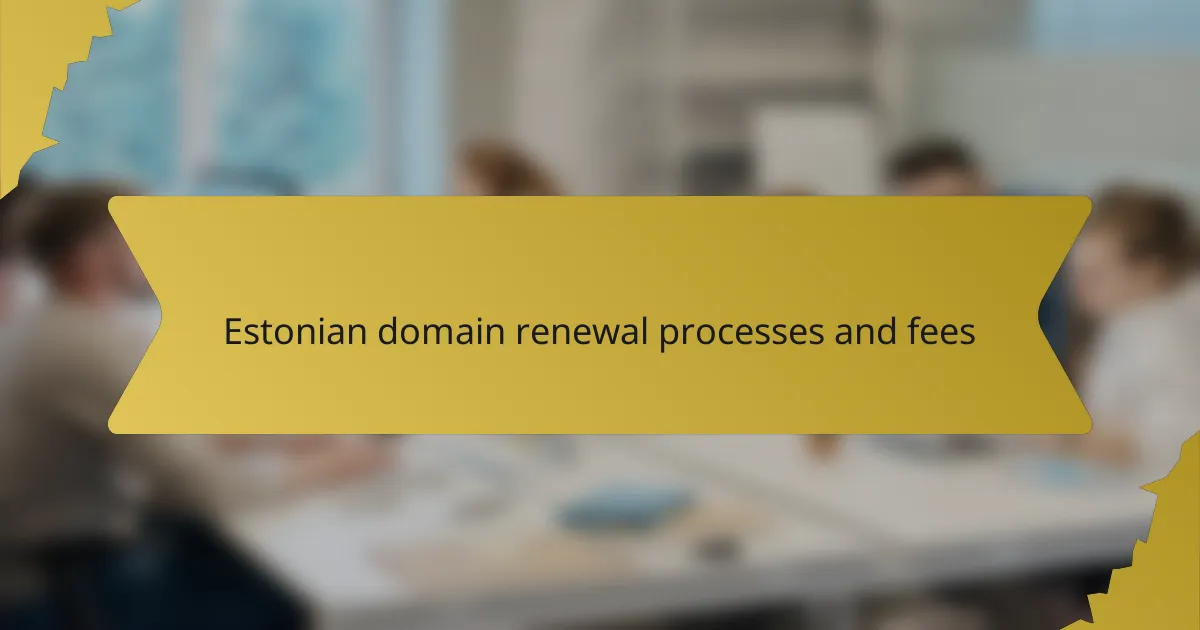Renewing an Estonian domain is a simple online process that requires timely action before the expiration date to maintain ownership. Renewal fees generally range from €10 to €30 annually, varying by registrar and domain extension. To successfully renew, ensure you verify ownership, select a payment method, and adhere to any registrar-specific conditions.
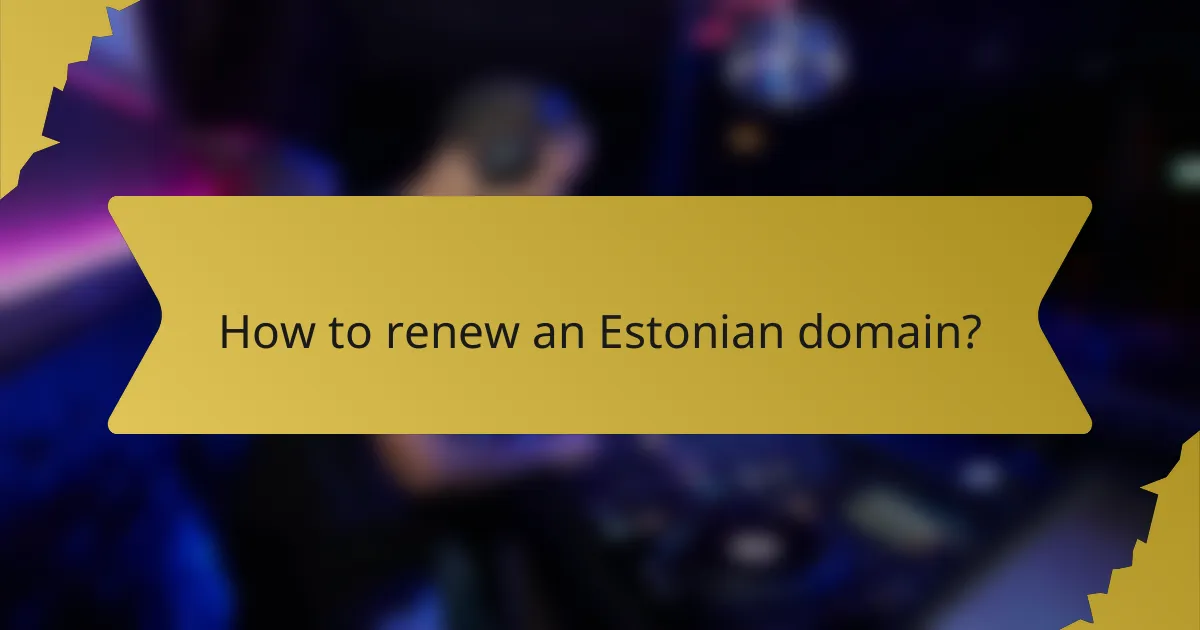
How to renew an Estonian domain?
Renewing an Estonian domain is a straightforward process that can be done online, via email, or by phone. It’s essential to complete the renewal before the expiration date to avoid losing ownership of the domain.
Online renewal through registrars
The most common method for renewing an Estonian domain is through an accredited registrar’s website. You typically log in to your account, navigate to the domain management section, and select the renewal option. Most registrars offer automatic renewal settings, which can help prevent lapses.
Fees for online renewal can vary, generally ranging from €10 to €30 per year, depending on the registrar and the domain extension. Always check for any additional charges that may apply.
Manual renewal via email
If you prefer a more traditional approach, you can renew your Estonian domain by sending an email to your registrar. Include your domain name, account details, and the renewal period you desire. This method may take longer than online renewal, so plan accordingly.
Be sure to confirm the renewal fee and payment methods in your email to avoid any misunderstandings. Keep a record of your correspondence for future reference.
Phone renewal options
Some registrars allow domain renewal over the phone. This can be a quick way to handle the process, especially if you have questions or need assistance. Call your registrar’s customer service number and provide the necessary details to complete the renewal.
When using this method, ensure you have your account information handy and clarify the renewal fee during the call. This can help you avoid unexpected charges later on.

What are the renewal fees for Estonian domains?
Renewal fees for Estonian domains typically range from approximately €10 to €30 per year, depending on the domain registrar and the specific domain extension. It’s essential to check with your registrar for the exact fees applicable to your domain.
Standard renewal fees
The standard renewal fees for Estonian domains generally fall between €10 and €30 annually. Most registrars offer competitive pricing, so it’s advisable to compare options before renewing. Some popular domain extensions, like .ee, may have slightly different rates.
Discounted rates for long-term renewals
Many registrars provide discounted rates for long-term renewals, often reducing the annual fee when you commit to multiple years upfront. For instance, renewing for three to five years can lead to savings of around 10-20% compared to annual renewals. Always inquire about any promotional offers that might be available.
Additional fees for late renewals
If you miss the renewal deadline, you may incur additional fees or face a grace period where the domain can still be renewed at a higher cost. Late renewal fees can vary significantly, sometimes adding €5 to €15 to the standard renewal price. It’s crucial to renew your domain on time to avoid these extra charges and potential loss of the domain.
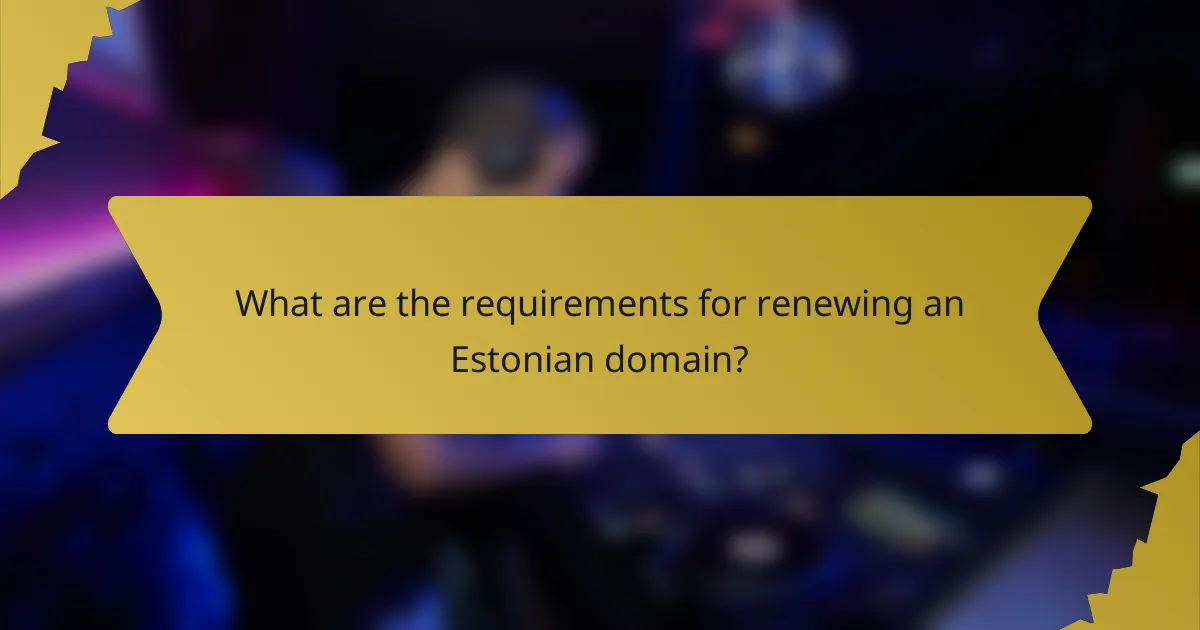
What are the requirements for renewing an Estonian domain?
To renew an Estonian domain, you must verify ownership, choose an acceptable payment method, and comply with any specific conditions set by your registrar. Understanding these requirements ensures a smooth renewal process and helps avoid service interruptions.
Valid ownership verification
Valid ownership verification is essential for renewing an Estonian domain. You typically need to provide proof of ownership, such as access to the email associated with the domain registration or specific identification documents. This step confirms that you are authorized to renew the domain.
Make sure your contact details are up-to-date in the registrar’s system to facilitate this verification. If you cannot access the required information, you may face delays or complications in the renewal process.
Payment method acceptance
Payment method acceptance varies by registrar, but most allow credit cards, bank transfers, and sometimes digital wallets. Ensure that your chosen payment method is supported to avoid issues during renewal.
Check if your registrar offers automatic renewal options, which can simplify the process and help prevent accidental lapses. Be aware of any fees associated with different payment methods, as these can vary significantly.
Registrar-specific conditions
Registrar-specific conditions can influence the renewal process. Each registrar may have unique policies regarding renewal periods, fees, and additional requirements. Familiarize yourself with these conditions to avoid unexpected complications.
For instance, some registrars may offer discounts for multi-year renewals, while others might impose penalties for late renewals. Always review your registrar’s terms and conditions to ensure compliance and to take advantage of any available benefits.
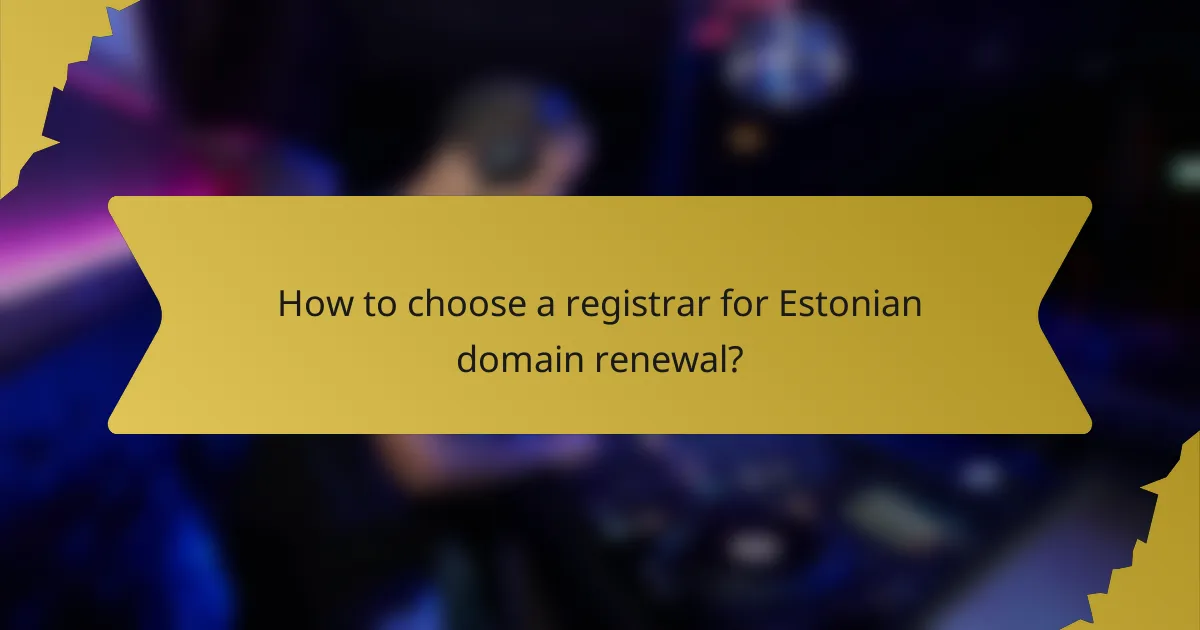
How to choose a registrar for Estonian domain renewal?
Choosing a registrar for Estonian domain renewal involves evaluating several key factors, including pricing, customer support, and reliability. It’s essential to select a registrar that meets your specific needs while ensuring a smooth renewal process.
Comparison of popular registrars
When comparing popular registrars for Estonian domain renewal, consider their pricing structures, renewal fees, and any additional services offered. Registrars like Zone, Elion, and Veebimajutus are commonly used, each with varying costs typically ranging from €10 to €30 per year.
Additionally, check for any hidden fees associated with renewal or transfer processes. Some registrars may offer discounts for multi-year renewals, which can be a cost-effective option for long-term domain management.
Customer support evaluation
Effective customer support is crucial when renewing your domain. Look for registrars that provide multiple support channels, such as live chat, email, and phone support. A registrar with responsive customer service can help resolve issues quickly, minimizing downtime.
Read customer reviews and testimonials to gauge the quality of support offered. A registrar with a solid reputation for customer service can save you time and frustration during the renewal process.
Service reliability and uptime
Service reliability and uptime are critical factors when choosing a registrar for Estonian domain renewal. Aim for registrars that guarantee high uptime percentages, ideally above 99.9%, to ensure your website remains accessible.
Check if the registrar has a history of outages or service disruptions, as this can impact your domain’s performance. A reliable registrar will also have robust security measures in place to protect your domain from unauthorized access or cyber threats.
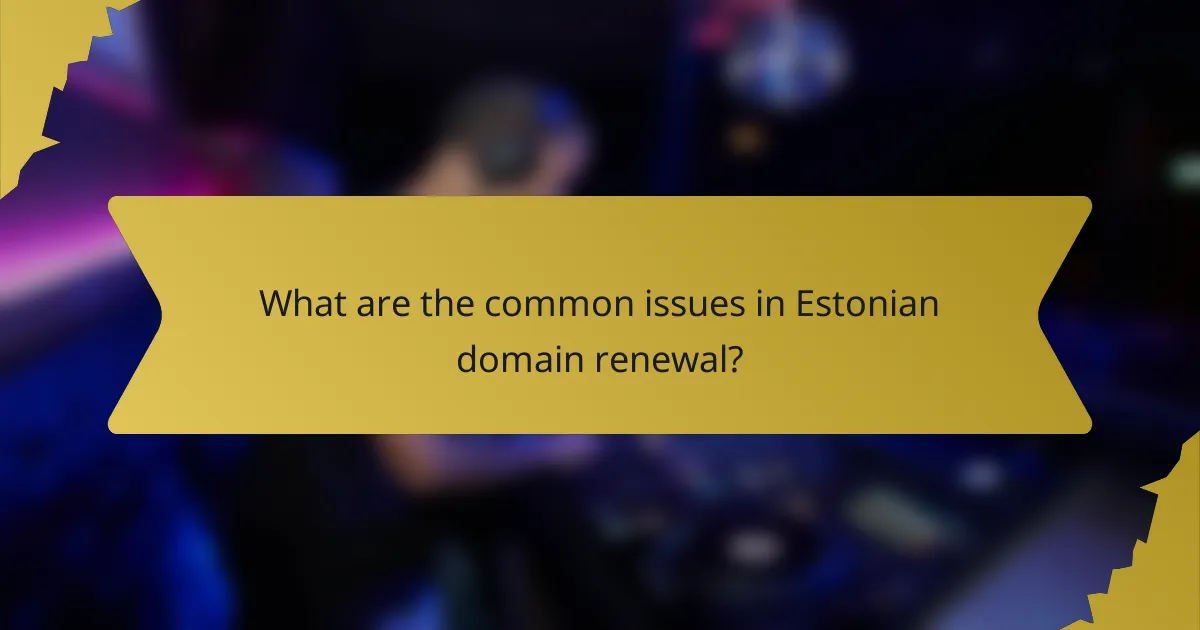
What are the common issues in Estonian domain renewal?
Common issues in Estonian domain renewal include payment processing delays, complications arising from domain lock status, and challenges in communication with registrars. Addressing these problems promptly can help ensure a smooth renewal process and avoid potential service interruptions.
Payment processing delays
Payment processing delays can occur due to various factors, including bank processing times and issues with payment gateways. In Estonia, it is advisable to initiate payments well in advance of the renewal deadline to avoid any disruptions.
Consider using direct bank transfers or reliable online payment methods to minimize delays. Always verify that the payment has been successfully processed by checking your registrar account status.
Domain lock status complications
Domain lock status can complicate the renewal process if the domain is locked for security reasons. A locked domain may prevent any changes, including renewal, until the lock is removed.
Check your domain’s lock status in your registrar’s control panel before attempting to renew. If the domain is locked, follow the registrar’s procedure to unlock it, which may require additional verification steps.
Registrar communication challenges
Communication challenges with registrars can lead to misunderstandings or delays in the renewal process. Issues may arise from unclear instructions, language barriers, or slow response times from customer support.
To mitigate these challenges, ensure you have all necessary information ready before contacting support. Use clear and concise language in your inquiries, and consider following up if you do not receive a timely response.
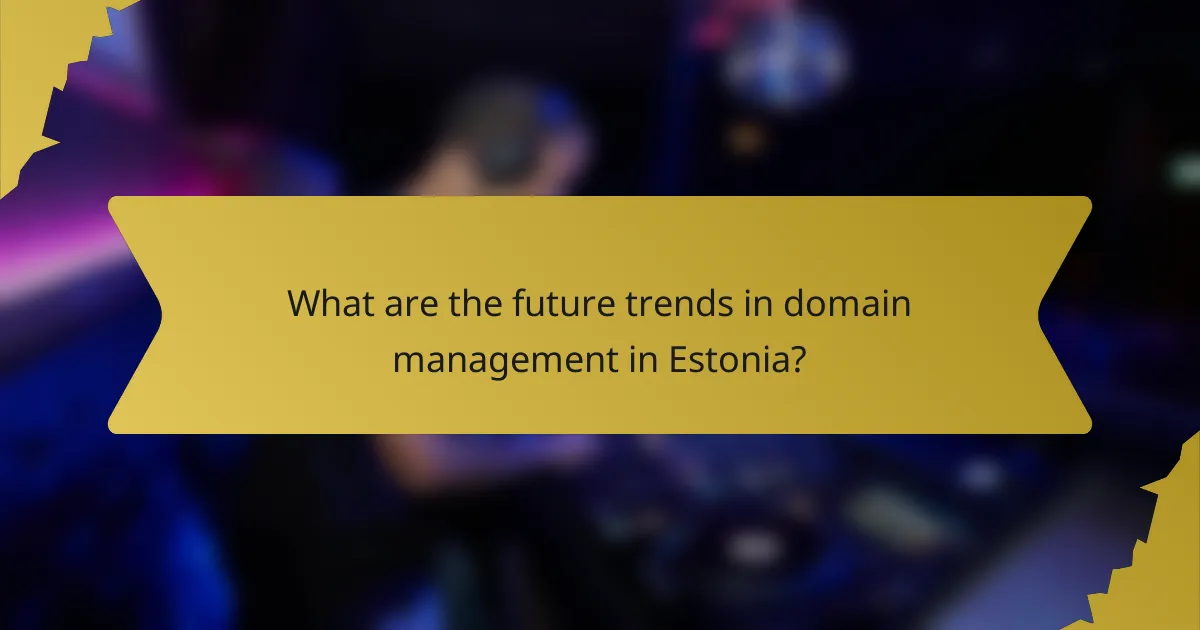
What are the future trends in domain management in Estonia?
Future trends in domain management in Estonia are increasingly focused on automation, enhanced security, and the integration of blockchain technology. These developments aim to streamline the registration process, improve user experience, and ensure greater protection against cyber threats.
Emerging technologies in domain registration
Emerging technologies are transforming domain registration by introducing innovative solutions that simplify the process. For instance, blockchain technology is being explored for its potential to provide decentralized domain ownership, which can enhance security and reduce fraud.
Additionally, artificial intelligence is being used to automate various aspects of domain management, such as renewal reminders and customer support. This can lead to faster response times and a more efficient registration process, benefiting both registrars and users.
As these technologies evolve, it is essential for domain registrars in Estonia to stay updated on trends and adapt their services accordingly. This may involve investing in new tools or partnerships to leverage these advancements effectively.
